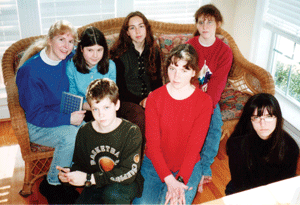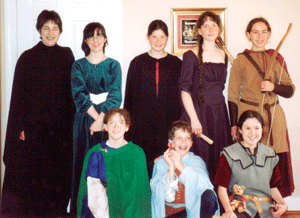
When my daughters were 13 and 15, we attended a conference on myth and
C.S. Lewis. The highlight of our weekend was meeting one of my
daughter’s favorite authors, who was receiving an award at the
conference. When we told her that both girls liked to write, she asked
if they would like to talk with her that afternoon. What a delight! When
they met, she encouraged them to practice writing and to keep learning
everything they could about their craft. “And when you are ready for
it,” she told them, “form a writing club so that you can receive
critiques on your writing.”
I smiled at that comment. My oldest daughter shared her writing with no
one but her younger sister.
When we got home, however, she declared that she thought she was ready.
Getting Started
We sent an email invitation to a wide group of middle-school and
high-school students. Those who showed an interest came to the first
meeting, and we shared our idea of forming a group to critique each
other’s writing. We would meet once a month and email the students’
writing pieces to the group in advance.
We also explained some practical rules, which our author friend had
given us.
Rules for Writing Clubs

|
|
Joyce and the members of the writing club
|
The first rule for the group was to
come prepared. Everyone must read
the stories before we met. We found this to be one of the most important
rules. When we later organized formally, the president made a habit of
reminding students to send in their writing pieces by a certain day.
Another email reminder served to exhort students to read the stories
before the club meeting.
Begin with Positive Comments
The second rule for our club was directed to those giving critiques:
everyone must begin with what they liked about the story. When it was
time to mention problems, the key was to focus on the work, not on
personal emotions. Instead of saying “I didn’t like . . .” a student
could say, “This part didn’t work for me because . . .” In this way the
author could understand the critique and decide whether editing was in
order.
A third rule was to be honest if the genre or message of the story did
not interest the person giving the critique. It helped for the author to
keep this in mind as she listened to the evaluation.
Being a Good Listener
The third rule applied to the author. During the critique the author was
not allowed to speak, except to ask for clarification, until everyone
had a turn. This kept the discussion from turning into a platform for
the author to persuade the “audience.” We wanted to remember that the
goal of critique was to help the authors learn where their writing was
not communicating effectively. If an author had been allowed to explain
beyond what was written, then the strength of the critique would be
weakened.
Writing for an Audience

|
|
Dressed up and ready for action
|
One surprising result of our writing club was how much it motivated our
children. Club members urged each other to write another chapter so that
they could learn what happened next. The club provided a reason for
writing now. The critiques also provided the impetus needed to improve
the stories. Some students shared their first chapters several times
before they were satisfied to move on to the second chapter. We enjoyed
watching how our feedback enriched the stories. Writing can be tough,
but having an audience makes all the writing and re-writing worthwhile.
Enrichment
Over the years other activities enhanced the writing club. For example
some of the mothers shared insights into writing (like, “Use active
verbs!”). The students also hosted discussion topics, such as, “What
makes you sympathize with the character’s emotions even if they are not
entirely justified?” The students also tried their hands at exercises,
such as writing a letter in the first person from one of their
characters. It helped them understand the personalities of their
characters better.
At one point we had five novels being written at once, with about one
chapter delivered to the group each month. It was humorous to see how
attached some of the students became to certain characters created by
their friends. At Christmas we invited the group to write Christmas
stories including any of the characters in the five novels. They emailed
them to each other in time for Christmas and enjoyed some new twists on
their creations.
A Writer’s Sketchbook
Writers can have sketchbooks, just as artists do. We challenged our
members to keep a verbal sketchbook with sections for “character
sketches,” “plot ideas and problems,” “interesting names and words,”
“sensory descriptions,” and “interesting pieces of conversation.” The
sketchbook was a place to think of fresh ways to describe the basics of
a character such as age and physical characteristics. For plot ideas,
students were challenged to think of ways to introduce unsolved problems
that would “hook” their readers. The section for interesting names and
words included names for people and places, as well as words that
intrigued the author. (New verbs are always handy when writing.) In all
descriptions for the writer’s sketchbook we reminded the students to use
several of the five senses and to aim for vivid details. Some of the
verbal sketches grew into stories.
Using the Internet

|
|
Intense discussion of writing concepts
|
Since we first began our writing club, the Internet has developed into a
more useful tool for groups. My sons now participate in a group that
posts their stories to a password-protected site. They use email to
announce meetings and remind members to check the website. The Internet
could also be used to form a club of members who meet by Internet rather
than in person.
Sharpening Our Skills
One of the reasons our author friend had given for forming a writing
club was to understand our audiences better so that we could write for
them. The students were often surprised at how certain plots intrigued
their readers while other plots fell flat. There was often a gap between
what they imagined in their minds and how it translated onto paper. The
writing club sharpened each person who participated. It also taught them
how to critique the work of another person in an effective way.
My daughter is now in college. The day they evaluated each other’s work
in her first video-editing course, she came home and told me how glad
she was that she had the experience of writing club, because it taught
her how to critique. Yet perhaps most importantly, the writing club
bridged the gap between creating for oneself and creating for others.
BONUS TIPS FROM JOYCE
Good Books for Writing Clubs
- Don’t Sabotage Your Submission by Chris Roerden
- The Elements of Style by Strunk and White
A Checklist for Critiques
- Did the opening grab your interest?
- Were there enough details to see the setting in your mind’s eye?
- Was the point of view consistent?
- If background details for the story were presented, was it done in
such a way that it didn’t confuse the reader or bog down the pace?
- Did the characters seem real? If not, why not?
- Was the protagonist a captivating character?
- Was the pacing appropriate? Too slow or too fast?
- Was there a good balance of narrative and dialogue?
- Did the dialogue ring true?
- Did you identify any typos, grammatical errors, clichés, etc.?
Writing Exercise
Write in the first person as one of your characters and answer the
following questions:
- What is your name?
- How old are you?
- Where do you live?
- What do you look like?
- Describe one thing you feel strongly about.
- What is the most interesting thing that has happened to you lately?
- What are you good at?
- What is one of your weaknesses?
- What is your idea of fun?
- What is one thing you would change about your life if you could?
A Sample Writing Exercise
We used this during a club meeting. Type the paragraph starters and
leave large spaces for the students to write. Print them out, cut the
pieces apart, and give each student a strip to complete. Allow about
fifteen minutes and then read the compiled story aloud.
Jane sat in the window seat watching the snow falling softly through the
trees. She was . . . (Describe Jane)
Jane sighed and wondered how much longer she would have to wait. The
sound of hurried footsteps heralded the arrival of her young cousin,
Plum. (Describe Plum.)
“Has it come yet?” Plum asked.
“No,” replied Jane. (Add more to this conversation.)
Jane lit a candle. “Let’s go to the front hall so we can be the first at
the door.” Plum followed her down the hall. (Describe the hall.)
Jane and Plum lived with their great-uncle James in Sudley Hall, which
had stood for over 500 years in Cherleton. (Describe the house.)
Jane and Plum had fallen into the habit of avoiding their great-uncle
James. He was . . . (Describe the great-uncle.)
|
Joyce McPherson is the creator of the online programs “Homeschool Tools”
and “Shakespeare Tools,” as well as the author of a series of
biographies for Greenleaf Press. With her husband, Garth, she
homeschools their nine children. She can be reached through
teachingtools.org or at mcpclan@comcast.net.